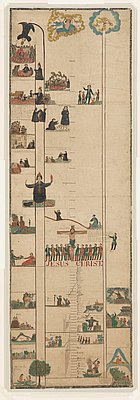- Catalog No. —
- Coll51_001
- Date —
- 1840
- Era —
- 1792-1845 (Early Exploration, Fur Trade, Missionaries, and Settlement)
- Themes —
- Oregon Trail and Resettlement, Religion
- Credits —
- Oregon Historical Society
- Regions —
- Columbia River Oregon Country
- Author —
- Francis Norbert Blanchet
Catholic Ladder
This restored Catholic Ladder, measuring six and one-half inches wide by fifty-eight inches long, is the oldest known ladder in existence. It was created by the French Canadian Catholic priest, Francis Norbert Blanchet, who arrived in Oregon in the fall of 1838.
Blanchet first developed the Catholic Ladder as a tool for Christian evangelization in the spring of 1839 when he journeyed to Cowlitz Prairie, located in present-day southwestern Washington State. Blanchet met with Natives from the surrounding prairie and from Whidbey Island in Puget Sound. Faced with the task of giving religious instruction to Indians who spoke a variety of languages, Blanchet hit upon the idea of devising a tool that would surmount the linguistic barriers. His initial ladder was the “Sahale stick” (or “stick from heaven” in Chinook Jargon). This self-standing wooden stick contained a visual representation of Christian history and Catholic theology, from the creation of the world to the Christian era, concluding with the arrival of Blanchet in the Pacific Northwest. The visual narrative, a type of memory-aid, relied on a system of simple notation. The forty centuries from creation to the Christian era were represented by forty marks, the thirty-years of Christ’s life by thirty-three points and a cross, and the period to Blanchet’s arrival by eighteen marks and thirty-nine points. Protestantism was represented as a withered branch of Christianity.
During a mission to the inter-ethnic French-Indian community in the Willamette Valley in the summer of 1839, Blanchet created what he referred to in French as the “historic ladder” (l’échelle historique). It eventually came to be known as the “Catholic Ladder.” This ladder was a two-dimensional representation of the same system Blanchet had used for the Sahale stick. Blanchet’s work among the Native wives and métis children of the French Canadian settlers in the valley relied heavily on this new ladder since most of the women and children were not fluent in French. This 1840 ladder contains words in French explaining the meaning of the symbols, which is absent in some later editions.
By the early 1840s, various handmade copies of Father Blanchet’s Catholic Ladder were in circulation among Indian and French Indian communities in the Northwest. It proved popular with the Native wives of former French Canadian fur trappers, and with segments of the region’s Indian population interested in the religious and cultural traditions of their French Canadian trading partners and kin relations. The Catholic Ladder was used in conjunction with formal Catholic catechism to evangelize the region’s Native peoples until 1881, when Oregon Catholic officials discontinued its use in favor of the formal catechism.
Click here to page through a guide to the Catholic Ladder on the OHS Digital Collections.
Further Reading:
White, Kris A. and Janice St. Laurent. “Mysterious Journey: The Catholic Ladder of 1840.” Oregon Historical Quarterly 97, 1997: 70-90.
Hanley, Philip M. History of the Catholic Ladder. Fairfield, Wash., 1993.
Written by Melinda Jette, © Oregon Historical Society, 2002.

